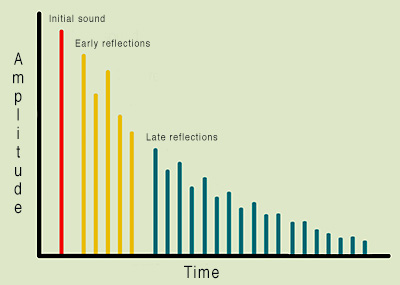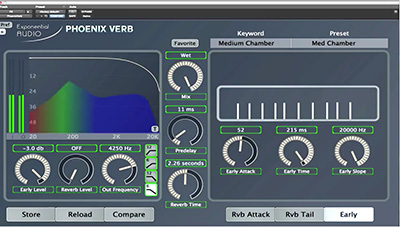![]() A long-time software developer and musician, Michael Carnes is the man behind US company Exponential Audio, which arrived in 2013 with its PhoenixVerb and R2 reverb plug-ins.
A long-time software developer and musician, Michael Carnes is the man behind US company Exponential Audio, which arrived in 2013 with its PhoenixVerb and R2 reverb plug-ins.
That both were reverb processors is no accident, as Carnes developed the groundbreaking 960L and PCM96 studio reverberation processors while at Lexicon, as well as being responsible for Lexicon’s plug-ins.
Professing a life-long interest in science, especially astronomy, cosmology, palaeontology and paleo-anthropology, Carnes has also worked in the fields of medical imaging and speech recognition among others. As a musician, he holds an advanced degree in classical composition, and has an impressive track record of performing and recording.
‘I’ve spent a lifetime in music and audio,’ he confesses. ‘In addition to my own music, I’ve recorded a number of other players and groups. Some of those recordings have been released on CD, and others have made it to NPR stations and even New Hampshire Public Television. I’ve recorded the Park City Chamber Music Festival [now the Beethoven Festival], as well as performers from the Utah Symphony. I previously recorded the Cambridge Chorale, a women’s chorus in Boston, as well as the new music group Tricinium.’
In this, the first of two interviews for Fast-and-Wide, he discusses early reflections – their place and importance in reverberation whether natural or electronically created.
One of the things about Exponential Audio plug-ins is their early reflection section. Can you explain what this is?
‘Early Reflections is a general term that we use to describe the first bounces of a sound as it hits floors, walls and ceilings. This covers the period of the first tens of milliseconds, although this may be much longer in the case of exterior sounds or very large spaces.

‘While we seldom hear those reflections as individual entities, they give us strong clues about what sort of environment the sound is in. They can also give additional clues about the location of the sound source. The reflections can either solidify imaging or they can interfere with it.’
You worked on a lot of ‘classic’ reverbs in years gone by. Those earlier reverbs don’t really have an early reflection section. Why is that?
‘There are a few reasons. One is that recording has changed a lot in the past couple of decades. Back then, the home studio/project studio was just getting started, and most recording took place in studios with good live rooms (or in real halls). Those places usually sounded good and the early reflections were a hallmark sound for each of them. Engineers used omnidirectional mics more frequently and those mics captured all the aspects of a good space, so an early reflection section was usually superfluous. The Lexicon reverbs I worked on typically had only one or two reflections per channel. While they could be helpful, they were often used to create backslaps or “effecty” sort of sounds.
‘Fast forward to now, and the recording world has changed completely. More of us are working in small rooms, sometimes treated, sometimes not. There’s more and more single-tracking, with only one player in the room. There are entire orchestras built up from synths and sample libraries. And a noisy world has driven us more toward directional mics. Without some help, these recordings can sound harsh and sterile, even when using a great vintage reverb. A good set of early reflections can help to move the players away from the microphone and to bridge that recording into the reverb tail. They can also help to create a feeling of mic leakage from other players – even when the recording is built up from individual tracks.
‘There’s one other reason for the scarcity of early reflections in that older generation of reverbs – there simply wasn’t enough CPU power! These reverbs nearly always used custom-built processors and those processors simply didn’t have the horsepower. Nowadays CPU power isn’t infinite, but it’s considerably advanced from what we had back then. Why not take advantage of it?’
When you say that early reflections may solidify or harm imaging, what do you mean?
‘If the first bounces come from the same general direction as the dry source, this can help anchor the apparent position of that source. Later reflections can also help establish the overall size of the space. But if those first reflections come from all around, they may indicate that the virtual mic is too far from the source or that the room is acoustically deficient. There are plenty of real-world examples – in a good concert hall, a listener can close his or her eyes and pinpoint the location of any player to within a foot or two of their actual position, but in some places (generally because of a reflective stage wall) that player’s position may vary wildly depending on the seat you’re sitting in. This can be an unpleasant listening experience.
Why might you want an ‘unpleasant’ set of early reflections?
‘For music, you rarely would want this. But in postproduction, this may be just what the doctor ordered. If the actors are in a small room, you may want to create the poor acoustics of the room. Or if you’re trying to match ADR (dialogue looping) with production sound, this may be needed to help match things for easier editing.’
Are your early reflections taken from real room measurements?
‘Only in the most general sort of way. There are basic characteristics of a reflection pattern that help lay out the space, but there’s not really a reason to try and match something exactly. Here’s why I think that’s so: In a real acoustic space – good or bad – you can move from seat to seat (let’s leave out the really bad seats under balconies) and the overall character of the room isn’t going to change a whole lot. The relative distance between you and the people on stage changes quite a bit and a measured impulse response would show rather large differences. Yet your sense of the room doesn’t change much. I think that shows that the tiny parts of the early reflection can change without giving a great sense of difference. There’s something about the general nature of the reflection pattern that sends the message. So I’ve focused on making patterns that cover the broad range of what’s helpful.’
It is sometimes argued that artificial reverb can only ever be an ‘effect’, because naturally occurring reverb is so heavily dependent not only on the reflective surfaces but also on atmospheric conditions, disturbances in the air, the sounds themselves – each reverberation event is a kind of ‘performance’. What are your thoughts on this?

This is one of the reasons I’m sceptical of convolution. An impulse response is a one-time snapshot of a pattern from a point source to a specific microphone location. Real reverberation is less linear, and a real ensemble involves several hundred point sources. But this drives to a deeper thing about reverb: I’m quite convinced we don’t hear it “photographically”. It takes a lot of energy to power a brain and evolution is parsimonious. There’s very little survival value in being able to discern the finer aspects of reverberation (unless you’re a developer). So I think that our ears and our aural cortex do a lot of data reduction on the after-effects of a sound. If we’re listening carefully we can reconstruct a lot of what may have happened, but there’s a level of detail that’s forever lost. There’s not really much point in worrying about things that won’t make it to the brain. It’s still important that an artificial reverb accounts for details like air absorption and the general character of a room. Various types of internal modulation can also provide some subtle moment-to-moment changes as well. Artificial reverbs are moving closer and closer to parity with a “real room” – at least insofar as we can perceive.
I’ll say one last thing to underline the point I’m making. Classical recording is generally considered to be the art that’s most concerned with capturing a real sense of space. But a session is generally bristling with microphones: Several to capture the room, mics over string and woodwind sections, spots for soloists and so on. Each one records a very different acoustic. The session may take place over a couple of nights of live concert, with a pickup session the next day. Mics don’t move, but the hall changes in terms of seating and humidity. If the edits are done well, we hear a comprehensive performance that sounds natural and free-flowing. We may complain about the singer’s vibrato, but we rarely hear about the reverb.
How do you edit early reflections?
‘This is going to differ for different developers, but I can tell you what I’ve done at Exponential Audio. I realised, going back to those days at Lexicon, that the last thing I wanted to do was to edit each individual reflection (time, level, phase) individually. It was extremely time-consuming and the result was not always what you expected. Extend that to the number of reflections in Exponential Audio reverbs (dozens to hundreds), and it becomes impossible to manage.
‘So I decided to create early reflection patterns – sets of reflections with a character I wanted (and always decorrelated)--and allow the preset developer to “rubber band” those. So you can stretch the pattern in time, from just a few milliseconds up to a few hundred, and they’ll maintain the same relative offsets to one another. Just turn a dial and the pattern stretches or compresses. I did the same thing for gain: you can push the gain toward the earliest reflections, set them to roughly equal values, or move the energy to the latest reflections. Overall gain of the system stays at equal power, no matter what you do. And this is just another dial on the GUI. There are also EQ options to simulate air absorption and to EQ the overall effect.
‘It’s reasonable to argue that this isn’t a “scientific” approach. You can’t specifically match the space you want. That’s valid, I suppose. But if I – as the developer – don’t want to edit with a calculator, is it fair to assume the end-user will? So my solution was simply to put entire control of that whole subsystem on a couple of dials. Turn them until you get what you like. I don’t want this to be intimidating. I want the user to get in and play.’
Any final tips regarding early reflections?
‘A couple. If you’ve recorded in a good room (at some distance from the source), or if you’re looking for a more vintage reverb sound, try turning reflections down or even off. Conversely, if you’re looking for a great small room, try turning the reverb tail down and building the space only with early reflections. You can then use a little bit of a short tail, turned down low, to give a sense of liveness to the room.’
The follow-up to this interview covers mixing in surround. Part of this will include an expansion on the use of early reflections in creating a complex mix.
For a video tutorial on early reflections, go to: https://youtu.be/tbey31VQqaQ